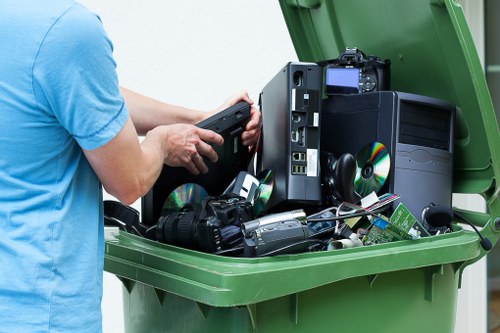Recycling and Rubbish in Furniture Disposal
Understanding Furniture Disposal

Furniture disposal has become an increasingly important issue in today’s environmentally conscious world. As consumers replace old pieces with newer models, the volume of discarded furniture continues to grow, posing significant challenges to waste management systems worldwide.
Proper disposal methods are essential not only to minimize environmental impact but also to promote sustainability. Recycling furniture offers a viable solution to reduce waste, conserve resources, and support eco-friendly practices.
In this article, we will explore the various aspects of recycling and rubbish in furniture disposal, highlighting the importance, methods, and benefits of responsible furniture management.
The Importance of Recycling Furniture

Recycling furniture plays a crucial role in reducing the environmental footprint associated with manufacturing new items. By reusing materials, we can significantly lower the demand for raw resources, thereby conserving natural habitats and reducing energy consumption.
Additionally, recycling helps in mitigating the accumulation of waste in landfills. Furniture items, especially those made of wood, metal, and plastic, can take years to decompose, releasing harmful substances into the soil and water.
Moreover, recycling supports the economy by creating jobs in the recycling and refurbishing industries. It also encourages innovation in designing furniture that is easier to disassemble and recycle, fostering a circular economy.
Common Types of Furniture Disposal Rubbish

When disposing of furniture, it’s essential to understand the different types of materials involved. Common disposal rubbish includes wood, metal, plastic, and upholstery, each requiring specific recycling processes.
Wooden furniture can often be repurposed or chipped for use in other products. Metal components, such as screws and frames, are highly recyclable and can be melted down to produce new metal products.
Plastic parts, including chair legs and table tops, need to be separated and processed according to their polymer types. Upholstered items can sometimes be cleaned and refurbished, extending their life cycle and reducing waste.
Methods of Recycling Furniture

There are several effective methods for recycling furniture, each tailored to the material composition and condition of the item. Here are some of the most common approaches:
- Donating: Gently used furniture can be donated to charities, shelters, or resale shops, giving it a second life and benefiting those in need.
- Refurbishing: Damaged furniture can be repaired or restored to its original condition, enhancing its usability and aesthetic appeal.
- Material Recovery: Breaking down furniture into its constituent materials allows for the recycling of individual components like wood, metal, and plastic.
- Energy Recovery: In cases where materials cannot be recycled, furniture can be utilized as a fuel source in energy recovery facilities.
Challenges in Furniture Recycling

Despite the benefits, recycling furniture presents several challenges that need to be addressed to improve efficiency and effectiveness.
One major obstacle is the complexity of disassembly. Modern furniture often combines multiple materials and intricate designs, making it difficult to separate components for recycling.
Furthermore, the lack of standardized recycling facilities and protocols can hinder the process. Regional differences in recycling capabilities and regulations add another layer of complexity to furniture disposal.
Benefits of Proper Furniture Disposal
Environmental Advantages
Proper furniture disposal through recycling significantly reduces the environmental impact by conserving resources and minimizing landfill waste. It lowers the carbon footprint associated with manufacturing new furniture and reduces deforestation by decreasing the demand for new wood products.
Economic Benefits
Recycling furniture contributes to the economy by creating job opportunities in the recycling sector. It also reduces waste management costs for municipalities and promotes the growth of sustainable businesses.
Social Impact
Donating or refurbishing furniture can have positive social effects by providing affordable furnishings to those in need. It fosters community involvement and supports charitable initiatives aimed at improving living conditions.
Best Practices for Furniture Disposal
Assess the Condition
Before disposing of furniture, evaluate its condition to determine whether it can be donated, refurbished, or needs to be recycled. Items in good condition are ideal candidates for donation or resale.
Separate Materials
Disassemble furniture to separate different materials such as wood, metal, and plastic. Proper separation facilitates efficient recycling and ensures that each material is processed correctly.
Choose the Right Recycling Facility
Identify and utilize local recycling facilities that specialize in furniture disposal. Researching their capabilities and requirements ensures that your furniture is handled appropriately.
Consider Environmental Certifications
Opt for recycling services that hold environmental certifications or adhere to eco-friendly practices. This guarantees that your furniture is recycled in a manner that minimizes environmental harm.
Future Trends in Furniture Recycling
Innovative Recycling Technologies
Advancements in recycling technologies are making it easier to process complex furniture items. Automated disassembly and material sorting systems are enhancing the efficiency of recycling operations.
Circular Economy Models
The adoption of circular economy principles in the furniture industry encourages the continuous reuse and recycling of materials. This approach aims to eliminate waste and promote sustainable production and consumption.
Consumer Awareness and Education
Increasing consumer awareness about the importance of recycling and proper disposal methods is driving demand for eco-friendly furniture options. Educational initiatives are empowering individuals to make informed decisions about their furniture disposal practices.
Conclusion

Recycling and responsible rubbish management in furniture disposal are critical components of sustainable living. By adopting effective recycling methods, overcoming challenges, and embracing future trends, we can significantly reduce the environmental impact of discarded furniture.
Implementing best practices not only benefits the environment but also supports economic growth and social well-being. It is essential for individuals, businesses, and communities to collaborate in promoting and practicing responsible furniture disposal.
Take action today by choosing sustainable disposal options for your furniture. Contact us today to learn more about our recycling services and how you can contribute to a greener future.